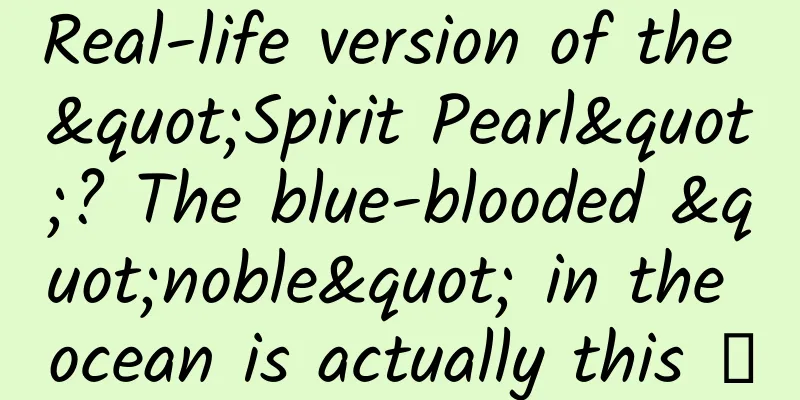Real-life version of the "Spirit Pearl"? The blue-blooded "noble" in the ocean is actually this →

|
"Color is part of the language of film" , this sentence is vividly demonstrated in the hit movie "Nezha 2". Among them, the fiery red of the magic pill Nezha and the deep blue of the spirit pearl Ao Bing are not only the clever setting of the character's color, but also symbolize their completely different personalities and destinies. Outside the fantastic world of mythology, the red and blue "gears of fate" are also quietly turning between humans and an ancient creature - the horseshoe crab (hòu). Oriental horseshoe crab specimen, photo by Wang Shan (River of Life exhibition area, Shanghai Natural History Museum) Species Name: Tachypleus tridentatus Classification: Arthropoda-Crombostomidae-Xipsisura-Limulidae-Limulus orientalis Protection status: Endangered in the IUCN Red List of Threatened Species, and listed as a national second-level protected wildlife in the National Key Protected Wildlife List. "Noble" blue blood? The color of blood is mainly determined by a respiratory pigment protein that carries and transports oxygen. The blood of humans and most animals is red because their respiratory pigment is hemoglobin containing ferrous ions. When the oxygen content is high, the iron ions in hemoglobin combine with oxygen to make the blood bright red, such as arterial blood; when the oxygen content is low, the iron ions combine with oxygen at a low degree, and the blood becomes dark red, such as venous blood. Therefore, the veins seen through the skin are not dark red, but are blue in contrast to the skin next to them and are subjectively identified as blue by the brain. Are there blue-blooded creatures in nature ? The answer is yes, and horseshoe crabs are one of them. Horseshoe crabs, also known as horseshoe crabs, are an ancient relict group that first appeared in the Ordovician period about 450 million years ago and were once very prosperous. About 200 million years ago, the appearance of horseshoe crabs gradually evolved and became fixed, and is basically the same as it is now. Having experienced five mass extinction events and outlived the famous trilobites and dinosaurs, horseshoe crabs have survived to this day and have become a veritable "living fossil of the ocean." Although the word "crab" is in its name, horseshoe crabs are more closely related to spiders, scorpions and mites in taxonomy, and all belong to the phylum Arthropoda and subphylum Chelicerata. Arthropoda "Family Tree" (Colorful Life Exhibition Area of Shanghai Natural History Museum) They have the basic body structure of the ancestors of chelicerates, which is divided into two body regions: the cephalothorax and the abdomen. The cephalothorax has 6 pairs of appendages, and the first pair of appendages are specialized as chelicerae. All of these appendages of horseshoe crabs are involved in feeding, forming a "mouth surrounded by legs", that is, a "trichostomum", which is why the class it belongs to is named after it. Today, there are only 1 family, 3 genera and 4 species of the class Trichostomidae: the Oriental horseshoe crab, the round-tailed horseshoe crab, the giant horseshoe crab and the American horseshoe crab . Except for the American horseshoe crab, which lives in the Gulf of Mexico and the eastern coast of North America, the other 3 species are distributed along the coast of Asia, and the Oriental horseshoe crab and the round-tailed horseshoe crab are naturally distributed along the southeast coast of China. Unlike hemoglobin in human blood, the respiratory pigment in horseshoe crab blood is hemocyanin containing copper ions. This protein is colorless in the deoxygenated state, but turns blue when combined with oxygen. Of course, in addition to horseshoe crabs, the blood of some arthropods and mollusks such as octopus, lobster, crab, etc. is also blue. What is different is that the blue blood of horseshoe crabs also has special medical value . Guardian from blue blood In the early 1950s, American pathologist Frederik Bang discovered that the blue blood of the American horseshoe crab would produce gel when it encountered Gram-negative bacteria. Further research showed that the endotoxins released by the bacteria activated the immune cells in the horseshoe crab, the amoeba-like cells , which released coagulation factors and formed gel to wrap the harmful bacteria, thereby blocking their spread. This characteristic makes the "horsehoe crab test" a revolutionary method for bacterial endotoxin detection! Bacterial endotoxin is a product of the death and lysis of Gram-negative bacteria, which is widely present in the environment. If it enters the human blood in large quantities, it will cause symptoms such as fever, nausea and even endotoxin shock. Therefore, before injectable drugs such as vaccines and medical devices such as syringes, infusion tubes, and stents come into contact with human blood or spinal cord, it is not enough to just kill the bacteria. The residual endotoxin must be controlled below a certain limit to ensure safety. Therefore, the accuracy of the test is very important. Before the discovery of the antibacterial ability of horseshoe crab blood, the U.S. pharmaceutical industry often used the "rabbit method" to detect bacterial toxins. The method was to inject the test sample into the rabbit's body and measure the rabbit's body temperature every 30 minutes for four hours to check whether the rabbit had a fever to verify whether the sample was contaminated. In addition to the test cost, sensitivity, and ethical issues involved, rabbits are also very likely to have a fever due to fright. Since horseshoe crab blood is 10 times more sensitive to endotoxin than rabbit tests and reacts quickly, around 1985, people began to collect horseshoe crab blood to extract active ingredients to make horseshoe crab reagents (LAL and TAL, representing horseshoe crab reagents made from the blood of American horseshoe crab and oriental horseshoe crab, respectively). Since then, horseshoe crab reagents have been widely used as a substitute for fever-inducing bacterial test items in safety assessments of injectable drugs and medical devices. Endangered blue blood 'living fossil' The application of horseshoe crab reagents has significantly improved the detection efficiency of bacterial endotoxins, silently protecting human health. However, while the blue blood of horseshoe crabs provides protection for themselves and humans, it also poses a danger to the horseshoe crab population. Due to multiple factors, the population of horseshoe crabs began to decline. In 2019, the World Conservation Union (IUCN) officially updated the status of the Oriental horseshoe crab in the Red List from "data deficient" to "endangered". Copyright images in the gallery. Reprinting and using them may lead to copyright disputes. Faced with the severe situation of a sharp decline in the number of horseshoe crab populations, humans are also taking positive actions. In 2019, more than 100 experts and scholars from 18 countries and regions around the world gathered in Beihai, Guangxi, and jointly issued the "Global Horseshoe Crab Conservation Beibu Gulf Declaration" and set June 20 as "International Horseshoe Crab Conservation Day." The following year, the World Conservation Union's Horseshoe Crab Specialist Group launched the "Asia-Pacific Horseshoe Crab Observation Station Network Project", and more than 20 units including the Beibu Gulf University College of Oceanography conducted routine monitoring of three species of Asian horseshoe crabs at 36 stations at home and abroad. In 2021, the Oriental horseshoe crab and the round-tailed horseshoe crab were included in the list of national second-class protected animals , providing legal protection for the protection of horseshoe crab resources. At the same time, horseshoe crab conservation research teams have been established, horseshoe crab protection areas have been established one after another, and the research on horseshoe crab reagent substitutes has also been steadily advancing. In the future, I believe that more and more members of the public will devote themselves to horseshoe crab protection and jointly help horseshoe crabs continue their life legend in their natural home. References [1] Zhang Mengqi, Zhang Kangfu. Symbols and emotions expressed by colors in Nezha: The Devil Child Comes into the World[J]. Design, 2021, 34(05): 22-24. [2] Deborah Kramer. "Desperate Situation: The Epic Journey of a Sandpiper and a Horseshoe Crab"[M]. 2020. [3] Jordan KG, Waleed A, Kristen D, et al. (2018) The Role of Horseshoe Crabs in the Biomedical Industry and Recent Trends Impacting Species Sustainability. Frontiers in Marine ence.185(5). [4] Liang Guangyao. Preliminary investigation of horseshoe crab resources in Beibu Gulf[J]. Guangxi Agricultural Science, 1985, (02): 18-20+16. [5] Smith DR, Brockmann HJ, Carmichael RH, et al. (2023) Assessment of recovery potential for the American horseshoe crab (Limulus polyphemus): An application of the IUCN green status process. Aquatic Conservation, 33(11). [6] Bao Yuyuan, Li Yinkang, Lin Wuying, et al. Survey of horseshoe crab resources in the northern coastal waters of the South China Sea and assessment of potential habitats for juvenile Chinese horseshoe crabs in the intertidal zone of the Beibu Gulf [J]. Biodiversity Science, 2023, 31(05): 80-90. [7] Maloney T, Phelan R, Simmons N. (2018) Saving the horseshoe crab: A synthetic alternative to horseshoe crab blood for endotoxin detection. PLoS Biol.16(10):e2006607. Planning and production Source: Shanghai Natural History Museum (ID: snhm01) Author: Zhang Xiaonan Shanghai Natural History Museum Exhibition and Education Center Reviewer: Huang Chengming, Researcher at the Institute of Zoology, Chinese Academy of Sciences Editor: Zhong Yanping Proofread by Xu Lailinlin |
Recommend
Nobel Prize winner warns: The fate of birds is our fate
With the sales of this little book, I would like ...
What is the current status of short videos? Big data tells you that Douyin is more popular and Kuaishou is more profitable!
In recent years, the popularity of "short vi...
These 5 types of cancer may be caused by what you eat!
This article was reviewed by Guo Xiaoqiang, a pop...
How to improve SEM conversion rate?
Among SEM techniques, reducing conversion costs i...
The data and effects of major mobile game launches are all here!
Mobile game traffic has three main sources: chann...
The "ginseng" in the desert, the "white ginseng" that was praised in the Han Dynasty, can actually cope with sandstorms?
Cistanche deserticola, also known as Cistanche de...
What happened to the Changchun epidemic in 2022? When will the unblocking end? Attached the latest news
Among the local epidemics in Jilin Province recent...
Mendel died in obscurity, but is now hailed as the father of genetics. What did he discover?
In today's biological community, everyone kno...
The world's first picture! "Omicron" VS "Delta", how big is the threat?
Strictly prevent the spread of the new coronaviru...
How to list on Android App Market in 2018
The user activity rate of domestic app stores has...
Creative formulas and ideas for advertising in the medical beauty industry!
Sponsors have started a war to grab market share,...
Learning copywriting is learning branding.
Last year there was a very controversial car adve...
Have you watched "Fang Hua"? Yes! I'm hungry after watching it! | Micro-diet therapy
Author: Fluent The most discussed and popular TV ...
Wenchang Tower Architectural Structure
The ancients attached great importance to Wenchan...
What is the difference between unemployment insurance and unemployment benefits? Can they be received at the same time?
Friends who participate in social security during...









